



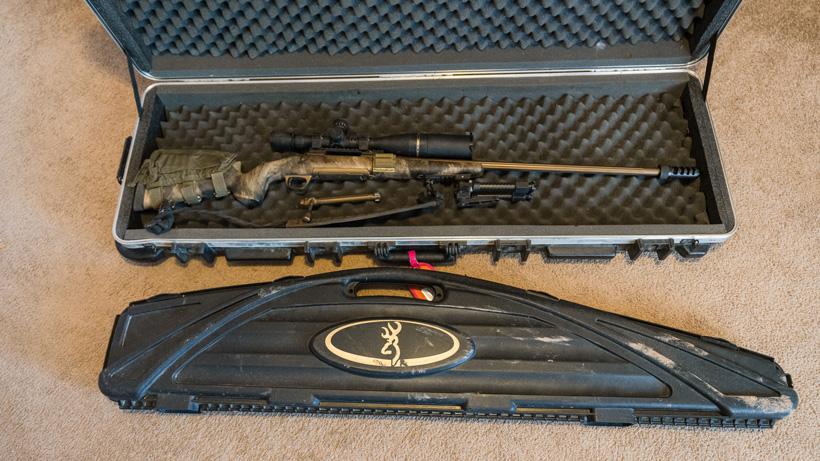
Even if the lower rifle case was more reinforced, I prefer to not use a case like this when flying.
Brand | Pelican |
|---|---|
Rifle case | V800 Vault Double Rifle Case |
Brand | Pelican |
Rifle case | V770 Vault Single Rifle Case |
Brand | Pelican |
Rifle case | 1750 Protector Long Case |
Brand | Pelican |
Rifle case | 1755 Air Long Case |
Brand | SKB |
Rifle case | Double Rifle Transport Case 5009 |
Brand | SKB |
Rifle case | iSeries 5014-6 Double Rifle Case |
Brand | SKB |
Rifle case | iSeries 4909-5 Single Rifle Case |
Brand | Rifle case |
|---|---|
Pelican | V800 Vault Double Rifle Case |
Pelican | V770 Vault Single Rifle Case |
Pelican | 1750 Protector Long Case |
Pelican | 1755 Air Long Case |
SKB | Double Rifle Transport Case 5009 |
SKB | iSeries 5014-6 Double Rifle Case |
SKB | iSeries 4909-5 Single Rifle Case |
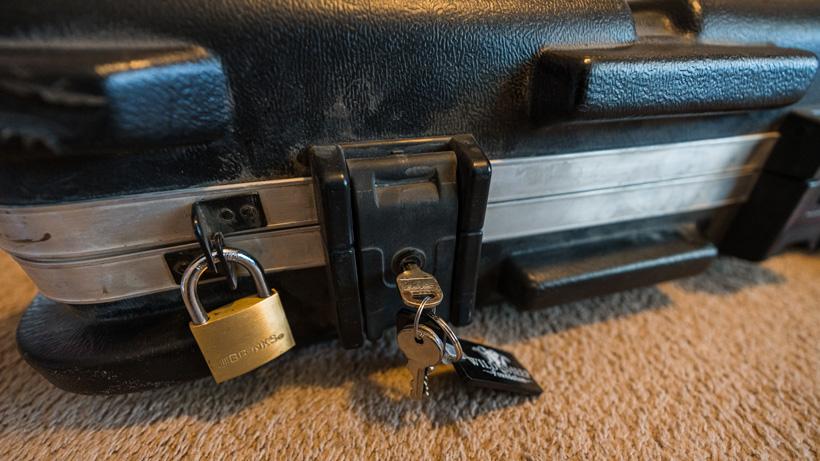
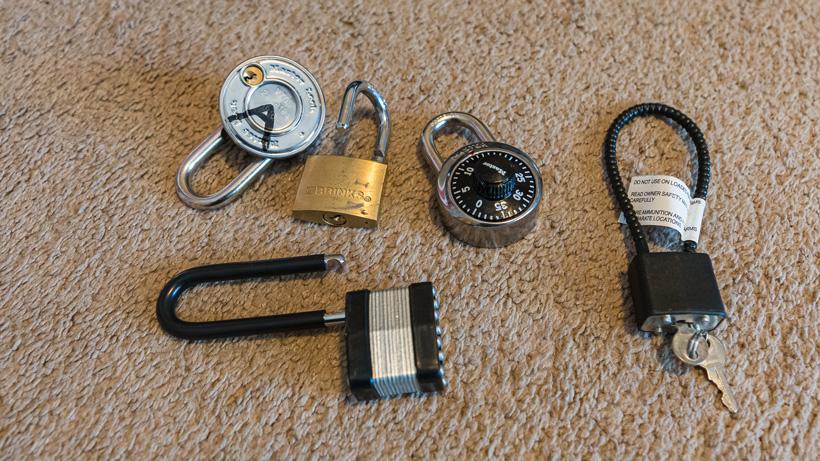
Various locks I've used while flying. Note: if you use a combination lock, I will mark each lock and then keep a paper copy of the combination in my bag, and take a photo of the combination and place in an album on my phone.
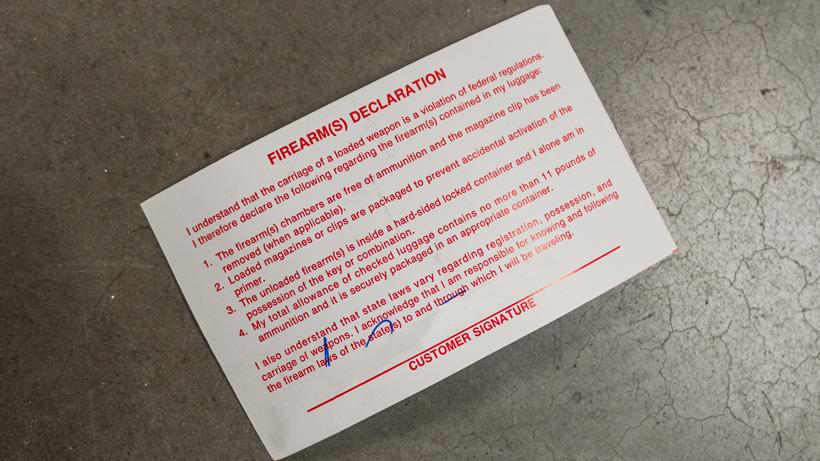
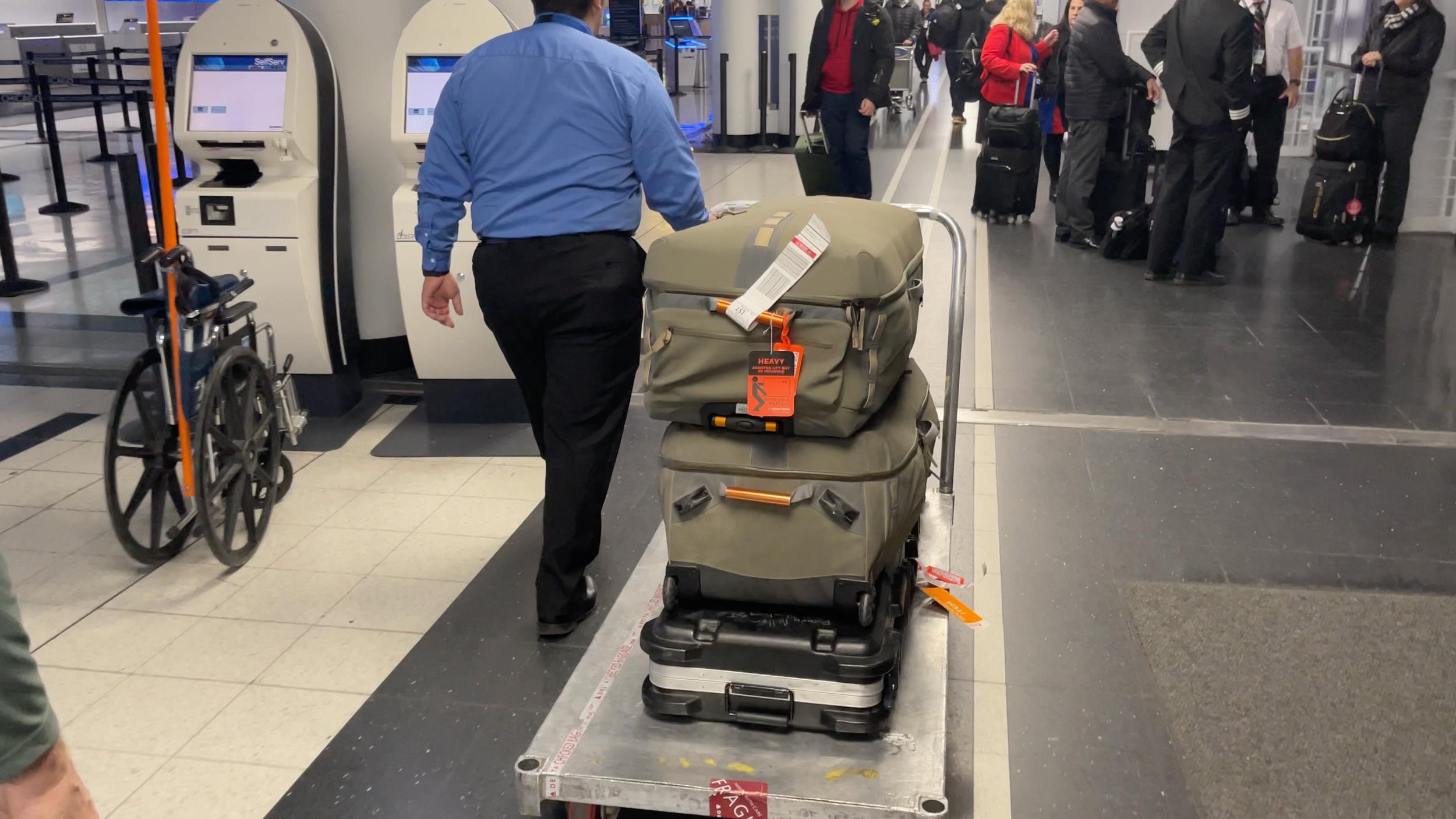
Rifle and hunting gear are getting taken back to an airport security room for scanning.
You may transport unloaded firearms in a locked hard-sided container as checked baggage only. Declare the firearm and/or ammunition to the airline when checking your bag at the ticket counter. The container must completely secure the firearm from being accessed. Locked cases that can be easily opened are not permitted. Be aware that the container the firearm was in when purchased may not adequately secure the firearm when it is transported in checked baggage.
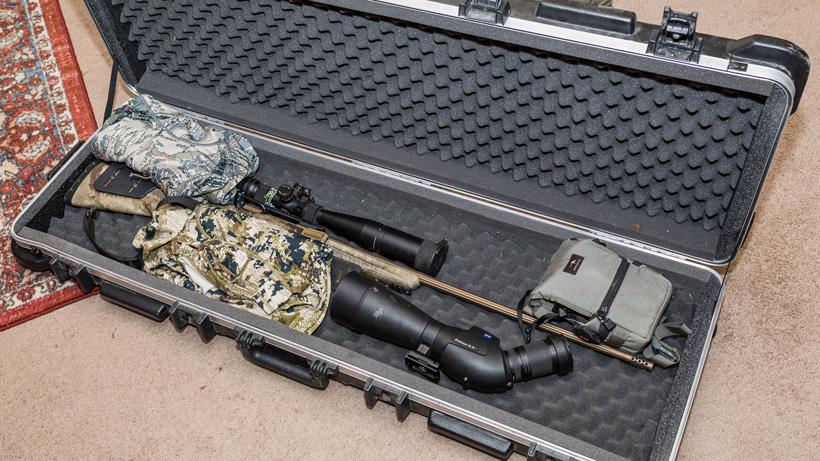
Packing firearm case with extra gear to maximize weight.


Zip tie on bow string and cables
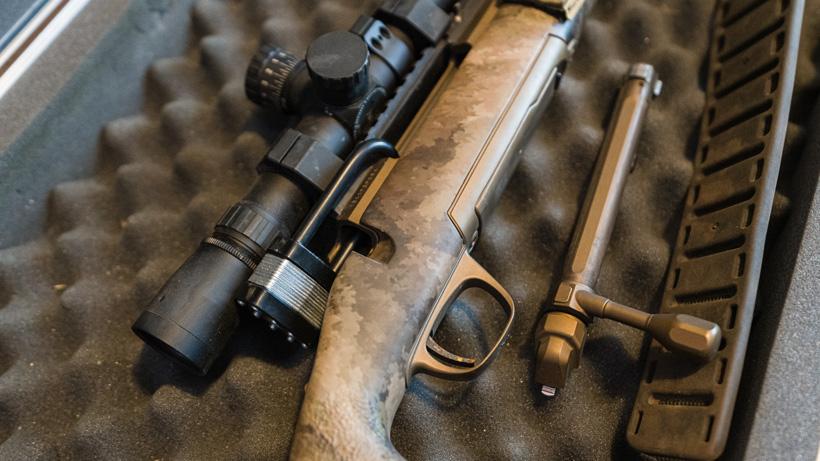
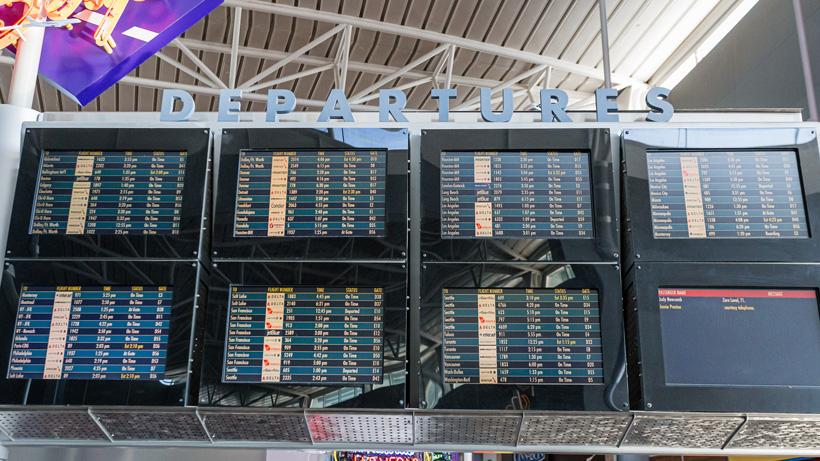
It’s that time of year. Application season is here, and we are now in the planning stages of what hunts we might draw and what adventures we are all looking forward to chasing. When it comes to planning hunts, one of the most significant decisions is whether you will drive to your hunt or fly.
Many people prefer to drive to their out-of-state hunting trip, but that isn’t always possible, so, for those situations, you need to transport your firearm or bow on an airplane.
Traveling with a rifle or bow isn’t very complicated, but there are certain precautions you need to take and resources you should check out well before you fly out to your next hunt.
Every year, I fly to at least one of my hunting destinations, and flying with a firearm is a breeze, in my opinion. This article is going to be jam-packed with some general tips I’ve learned over the years when flying across the United States on hunts and also flying internationally on hunts. I'll include some information directly from TSA on transporting a firearm and how you can look up the rules for yourself.
Keep in mind that it’s always best to check with your airline before you fly to see if they have changed any of the firearm regulations or security requirements. Also, if you’re flying internationally, you need to check the U.S. Customs and Border Protection website for information and requirements prior to travel.
Note: With muzzleloaders growing in popularity, you need to know that you cannot fly with loose blackpowder or loose primers caps on any airline. You can fly with a muzzleloader, but you cannot fly with the powder and primers. You must ship those to your destination ahead of time. See the TSA ruling on blackpowder here.
To transport a firearm in an airplane, you must have the weapon unloaded and in a locked, hard-sided container. I prefer a well-built gun case like the ones made from Pelican, SKB, or various metal cases, and I always fly with a double firearm case.
I will spend a little extra money on a quality gun case, knowing it will protect my gun on all the airlines to my final destination. I’ve used my current rifle case for 12-plus years, and it’s still going strong.
Be aware that the small lightweight plastic case you might have gotten when you purchased your rifle is not going to cut it! I also like cases that have some airtight qualities because, once I land, the case will most likely ride around in the back of the truck for a while.
Below are a few rifle case suggestions that you can use when flying. I only have listed the ones I have personally used, or directly know friends who use them. I'm sure there are lots of other great options.
When flying, I also prefer cases that don’t look like rifle cases.
Some single rifle case looks too much like a weapon (as they are shaped like a rifle). You never know if someone loading your gun case into the plane will toss it harder if they know it’s a weapon based upon its shape. Also, it’s a lot easier to toss a hard-sided single rifle case that doesn’t weigh anything compared to my double rifle case filled with extra gear that I make sure weighs exactly 50 pounds.
Another thing you need to do when flying with a weapon is to supply your own locks. Any spot on the case that can fit a lock should have a lock.
Various locks I've used while flying. Note: if you use a combination lock, I will mark each lock and then keep a paper copy of the combination in my bag, and take a photo of the combination and place in an album on my phone.
I personally don’t use the Transportation Security Administration (TSA) approved locks. The reason I don't use TSA locks is because if you use them, then any TSA agent could access my rifle. According to TSA, "you may use any brand or type of lock to secure your firearm case, including TSA-recognized locks." I used to use key locks, but I’ve started to prefer the twist combination locks.
When I arrive at the airport and find my airline area, I will search for an agent or find the “Special Items” line, which is normally near the main ticketing area. This is where I will declare to an agent that I am transporting a firearm. That part is important; you need to declare to an airline representative that you are checking a firearm.
The biggest thing I will mention here is to be nice. They are doing their job. So, just be nice and courteous to any airline agent. They have a stressful job as it is, and you don't need to make their day more stressful by not being nice to them. Being nice will also make this process super smooth.
Once you are with the airline representative, you will weigh your luggage like normal, and then you'll weigh your rifle case. The agent will hand you a piece of paper, and you will need to sign it (typically, this is a firearms declaration form that says your firearm is unloaded). When you get the baggage and firearm case luggage receipts back, make sure you keep them on you at all times.
If everything is okay, you will then be able to lock up your case. I'll typically ask at this point if it's okay for me to lock my case now. Sometimes, they will ask you to wait; other times, you can lock them at this point.
The next step can go in a few different ways depending on the airline.
The majority of the time, an airline representative will then walk you over to a special item room, where a different agent might have you open up your rifle case to make sure it’s unloaded. Sometimes, they will also take a few swab samples. Sometimes they will also take your other bags back to be scanned, but most of the time your other checked baggage will go through normal scanning.
Note: once you take your weapon back to the special room and set it down, do not touch the rifle case. Most of the special agents will tell you this, but it’s for their safety and yours.
What makes things even easier during this entire process is to remove the bolt from your rifle and place a lock through the action. That way, a TSA agent will easily see your rifle is fully unloaded and 100% safe.
I will stress this again: you must have your own locks. Do not assume that just because your hard case has TSA-approved locks built in, that they will work. You physically need to be the one to open and close the locks.
Once, when flying back from a mule deer hunt in Montana, I lost my locks. I got to the airport and, after talking to the very lovely agents, they told me they keep a few locks on hand in case things like this happens. The TSA-approved locks were not enough. The agent mentioned that I would have to pay for the locks, which I totally said I’d gladly pay. When she returned, I was given the locks and their code. The TSA agent then told me the locks were free. It pays to be extra nice when transporting a firearm! Never allow your weapon case to leave with everything locked up.
Once you land at your final destination, you will need to pick up your firearms at some sort of “baggage service office” for the airline you're flying with. Your firearm will not arrive with your other luggage 90% of the time. However, there have been times when I’ve flown, and my firearm case somehow makes it down the chute with everyone else’s luggage. It should go without saying since you’re at an airport, but you will once again need to present an ID to pick up your weapon.
This also goes for flying with bows as well. So don't expect your bow case to arrive with your main luggage either.
Firearms
The above information was from: TSA Transporting firearms and ammunition
Let’s face it: flying with hunting gear can be expensive! You have to pay for your checked firearm and, then, most likely one or two other checked bags, then there is transporting the meat home in a cooler or a soft-sided cooler as well. Those fees quickly add up! Check out this article: Multiple benefits for using a soft-sided cooler when hunting/traveling as a way to potentially save some coin when flying meat home.
To avoid giving the airports more of my money, one trick I’ve used throughout the years is to utilize a large hard-sided double firearm case (the type that is built for multiple firearms). A double rifle case also works when flying with a bow. I prefer to use a double firearm case because since a firearm has to be checked, it’s already going to cost you money to check that firearm as a “bag” on most airlines. So, you might as well utilize all of the space and weight that you can.
This is why I never use a single rifle case because it only can hold a rifle and none of your gear. Remember the example above when I described airlines could beat up on cases that look like a rifle? This is, again, why a double rifle case is a huge deal!
For example, if your airline allows a checked bag to weigh 50 pounds, I will place a bunch of my hunting gear next to my rifle in that double rifle case. Items include clothes, headlamps, rear shooting rest, tripod, etc. You could place your spotting scope, rangefinder, and binoculars in your rifle case. But one additional tip I'll give is I like to fly with my optics in my carry-on luggage whenever possible. Sometimes, that isn't possible if you have a very large spotting scope.
The hard-sided rifle case adds so much protection! Next, I will take several layers of clothes and place them on my rifle for added protection.
Again, remember this tip: If you have room in your carry-on bag, I highly suggest placing your binoculars or spotting scope in your carry-on bag. This way, you can be sure those expensive items are with you at all times.
In my mind, flying with a bow is a breeze. A bow IS NOT held to the same firearm special checks and regulations when flying. A bow is now a firearm. However, keep in mind that some TSA agents will argue with you on this and will want you to check it as a firearm. So, I still advise people to arrive early, just in case the TSA agent requires you to check it as a firearm.
One trick for flying with a bow is to place a zip tie around the string and cables. That way, no one can somehow dry fire your bow. Dry firing could happen if they somehow don’t allow you to be in the room when they take it back to inspect it. Better to be safe than sorry. Also, I’ll use a bow sleeve to protect my strings and cams. I always use a sight cover when in the mountains, but if you don’t have one, get a little small protective sleeve to put over your bow sight to protect your pins. In a pinch, a Crown Royal bag could work great.
To make things even smoother when going through a security checkpoint with a firearm, I'll remove the bolt from the rifle, and place a padded lock where the bolt was. This makes it even easier for a TSA agent to see that my firearm is unloaded.
You never know what might happen (something in the barrel, case stuck, etc.), and not having a cleaning rod in a truck will mean you don’t have to hike out of the mountains and drive two-plus hours to a town to get one. You never know what could happen— and packing one doesn’t take up a lot of space.
You can transport your ammo in the same case that holds your rifle, or in a different checked back.
Even though you can have your ammo in the same case as the rifle, I prefer placing the ammo in a hard plastic case that then goes in my duffel bag that is also checked. According to TSA, you must place your ammo “in a fiber (such as cardboard), wood, plastic or metal box specifically designed to carry ammunition and declared to your airline.” If your ammo is in a ziplock bag or some other soft-sided holder, it might get confiscated. Do yourself a favor and get some of the plastic ammo holders before you fly.
However, you also must have all “gun parts” in the main hard-sided case. You cannot take your magazine off your rifle and place it in a different checked bag when flying in the United States.
Keep in mind that you should always check TSA regulations and the specific airline you are flying before you get to the airport, as rules do change on how to transport a firearm from time to time.
Flying with a rifle or a bow should not be a stressful endeavor. Just remember to double and triple-check the regulations and arrive at the airport with plenty of time before your flight. I cannot stress this enough! Then, above all else, smile, be extra kind, and thank each airport agent for helping you out.
After all of the above required steps, you’ll be on your way to your next hunt of a lifetime stress-free!
This article was originally published on October 15, 2019, and has been updated with more information.
When traveling, comply with the laws concerning possession of firearms as they vary by local, state and international governments.
If you are traveling internationally with a firearm in checked baggage, please check the U.S. Customs and Border Protection website for information and requirements prior to travel.
Declare each firearm each time you present it for transport as checked baggage. Ask your airline about limitations or fees that may apply.
Firearms must be unloaded and locked in a hard-sided container and transported as checked baggage only. As defined by 49 CFR 1540.5 a loaded firearm has a live round of ammunition, or any component thereof, in the chamber or cylinder or in a magazine inserted in the firearm. For civil enforcement purposes, TSA also considers a firearm to be loaded when both the firearm and ammunition are accessible to the passenger. For example, if an individual has a firearm in accessible baggage and ammunition in his/her pocket, or any combination where the individual has access to both, the firearm is considered "loaded" for purposes of assessing a civil penalty. Only the passenger should retain the key or combination to the lock unless TSA personnel request the key to open the firearm container to ensure compliance with TSA regulations. You may use any brand or type of lock to secure your firearm case, including TSA-recognized locks.
Bringing an unloaded firearm with accessible ammunition to the security checkpoint carries the same civil penalty/fine as bringing a loaded firearm to the checkpoint. You may find information on civil penalties at the Civil Enforcement page.
Firearm parts, including magazines, clips, bolts and firing pins, are prohibited in carry-on baggage, but may be transported in checked baggage.
Replica firearms, including firearm replicas that are toys, may be transported in checked baggage only.
Rifle scopes are permitted in carry-on and checked baggage.